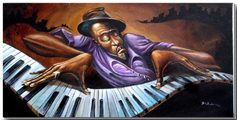
 So you’re feeling kind of funky and you want to lay it down. If you have never written in a funk style, or have never added any funky grooves to your songs, here are a few tricks that will instantly funkify your songwriting.
So you’re feeling kind of funky and you want to lay it down. If you have never written in a funk style, or have never added any funky grooves to your songs, here are a few tricks that will instantly funkify your songwriting.
Even though you could apply a funk feel to any type of chord progression, the majority of funk music is played over one single chord. This usually occurs as a part of a balancing act. If one component of the music is extremely active, it is common to balance that by having other components remain less active, otherwise a song runs the risk of sounding too busy and chaotic. And since funk rhythms tend to be quite active, this is often brought into balance with the rest of the music by simplifying the chord progressions, often down to just one chord for a song section, and sometimes for the entire song.
Another feature of Funk music is the use of dominant seventh chords, often simply referred to as seventh chords, which are different from major seventh chords. And it is common to add the ninth or thirteenth as upper extensions to the these chords (but not the eleventh because it will clash with the major third of the chord, which lies a half-step below it). Sex Machine, by James Brown, utilizes an Eb7 chord within the guitar part, which adds the 9 as an upper extension, and also interjects the 13 periodically.
The rhythmic component of Funk music is a sixteenth-note feel. Where a quarter-note feel in 4/4 time is counted 1-2-3-4 (4 beats per measure in 4/4 time), and an eight-note feel is counted 1-and-2-and-3-and-4-and (8 beats per measure in 4/4 time), a sixteenth-note feel will be counted as 1-e-and-a-2-e-and-a-3-e-and-a-4-e-and-a (16 beats per measure in 4/4 time). The Sixteenth-Note feel adds a lot of rhythmic complexity to the music.
But the key to making this sixteenth-note feel sound funky lies in the art of syncopation. Where a straight feel might accent the instruments and vocals on the numbered beats and the “ands,” a syncopated feel will more commonly accent the off-beat subdivisions such as the “e” or the “a.” This is the primary way to create that funk feel. You can write out your rhythms with numbers or music notation, which is not a bad idea, but it is often just as effective to get a feel for these grooves in the same way a dancer might feel the music. Funk music is essentially a form of dance music.
Sparseness is the next step. Leave a lot of space and rests within the instrumental parts. Non-stop sixteenth notes, or any type of notes, will kill your groove. It is often the notes that you don’t hear that bring out the notes that you do hear in Funk music.
And last but not least, complex bass lines that outline a single chord and employ the rhythmic concepts mentioned above are an essential component of a funk feel. The best bass players I have seen and performed with were masters of the Funk style. And the biggest tip to making your bass lines sound funky does not have to do with slapping. That can be an impressive technique, but it is not the key to this style. The trick is to add a lot of percussive muted notes in between the notes with pitches and the rests. This can be accomplished whether slapping or playing standard finger style with the plucking hand. But if you are writing on the guitar or piano you can often wait on creating the bass ideas until later when you are with a full band.
Beginning a new song with the Funk style in mind will surely inspire a unique and different type of song than if you began with a straight feel using basic major and minor chords, and then tried to funkify the arrangement after the song was written. I suggest starting a new song and applying some of these concepts to just how funky you can get, you might surprise yourself!
Watch This Video
from the Songwriting Sparks Video Course
13-step Songwriting Blueprint,
from boring song to Radio Ready HIT!
The post How to be a Funkosaurus appeared first on Songwriting Planet.
Read more: songwritingplanet.com
